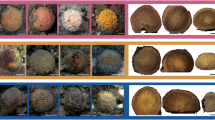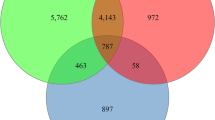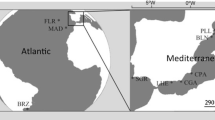Abstract
Does diversity beget diversity? Diversity includes a diversity of concepts because it is linked to variability in and of life and can be applied to multiple levels. The connections between multiple levels of diversity are poorly understood. Here, we investigated the relationships between genetic, bacterial, and chemical diversity of the endangered Atlanto-Mediterranean sponge Spongia lamella. These levels of diversity are intrinsically related to sponge evolution and could have strong conservation implications. We used microsatellite markers, denaturing gel gradient electrophoresis and quantitative polymerase chain reaction, and high performance liquid chromatography to quantify genetic, bacterial, and chemical diversity of nine sponge populations. We then used correlations to test whether these diversity levels covaried. We found that sponge populations differed significantly in genetic, bacterial, and chemical diversity. We also found a strong geographic pattern of increasing genetic, bacterial, and chemical dissimilarity with increasing geographic distance between populations. However, we failed to detect significant correlations between the three levels of diversity investigated in our study. Our results suggest that diversity fails to beget diversity within a single species and indicates that a diversity of factors regulates a diversity of diversities, which highlights the complex nature of the mechanisms behind diversity.






Similar content being viewed by others
References
Aiello, A., P. Ciminiello, E. Fattorusso & S. Magno, 1988. 3-Beta, 5-alpha-dihydroxy-6-beta-methoxycholest-7-enes from the marine sponge Spongia agaricina. Journal of Natural Products 51: 999–1002.
Arrieta, J. M., S. Arnaud-Haond & C. M. Duarte, 2010. What lies underneath: conserving the oceans’ genetic resources. Proceedings of the Natural Academy of Sciences 107: 18318–18324.
Balloux, F., W. Amos & T. Coulson, 2004. Does heterozygosity estimate inbreeding in real populations? Molecular Ecology 13: 3021–3031.
Becerro, M. A., 2008. Quantitative trends in sponge ecology research. Marine Ecology 29: 167–177.
Becerro, M. A., X. Turon & M. J. Uriz, 1997. Multiple functions for secondary metabolites in encrusting marine invertebrates. Journal of Chemical Ecology 23: 1527–1547.
Bell, J. J., 2008. The functional roles of marine sponges. Estuarine, Coastal and Shelf Science 79: 341–353.
Bertrand, J. C. & J. Vacelet, 1971. Association between Corneal and Bacterial Sponges. Comptes Rendus Hebdomadaires Des Seances De L Academie Des Sciences Serie D 273: 638–641.
Bewley, C. A., N. D. Holland & J. D. Faulkner, 1996. Two classes of metabolites from Theonella swinhoei are localized in distinct populations of bacterial symbionts. Experientia 52: 716–722.
Blanquer, A. & M. J. Uriz, 2010. Population genetics at three spatial scales of a rare sponge living in fragmenteed habitats. BMC Evolutionary Biology 10: 13.
Brook, B. W., D. W. Tonkyn, J. J. Q’Grady, & R. Frankham, 2002. Contribution of inbreeding to extinction risk in threatened species. Conservation Ecology 6: 16.
Cardinale, B. J., M. A. Palmer & S. L. Collins, 2002. Species diversity enhances ecosystem functioning through interspecific facilitation. Nature 415: 426–429.
Casamayor, E. O., H. Schafer, L. Baneras, C. Pedros-Alio & G. Muyzer, 2000. Identification of and spatio-temporal differences between microbial assemblages from two neighboring sulfurous lakes: comparison by microscopy and denaturing gradient gel electrophoresis. Applied and Environmental Microbiology 66: 499–508.
Castritsi-Catharios, J., M. Magli & J. Vacelet, 2007. Evaluation of the quality of two commercial sponges by tensile strength measurement. Journal of the Marine Biological Association of the United Kingdom 87: 1765–1771.
Chapman, J. R., S. Nakagawa, D. W. Coltman, J. Slate & B. C. Sheldon, 2009. A quantitative review of heterozygosity–fitness correlations in animal populations. Molecular Ecology 18: 2746–2765.
Cimino, G., S. de Stefano, L. Minale & G. Sodano, 1975. Chemical patterns and classification of the Demospongiae. Comparative Biochemistry and Physiology 50B: 279–285.
Clarke, K. R. & R. M. Warwick, 2001. Change in Marine Communities: An Approach to Statistical Analysis and Interpretation. 5-Primer-E Ltd, Plymouth Marine Laboratory, UK.
Coltman, D. W. & J. Slate, 2003. Microsatellite measures of inbreeding: a meta-analysis. Evolution 57: 971–983.
Da Silva, A., et al., 2009. Heterozygosity–fitness correlations revealed by neutral and candidate gene markers in roe deer from a long-term study. Evolution 63: 403–417.
De Caralt, S., M. J. Uriz, A. V. Ereskovsky & R. H. Wijffels, 2007. Embryo development of Corticium candelabrum (Demospongiae: Homosclerophorida). Invertebrate Biology 126: 211–219.
Diaz, M. C. & K. Rutzler, 2001. Sponges: an essential component of Caribbean coral reefs. Bulletin of Marine Science 69: 535–546.
Duran, S., M. Pascual, A. Estoup & X. Turon, 2004a. Strong population structure in the marine sponge Crambe crambe (Poecilosclerida) as revealed by microsatellite markers. Molecular Ecology 13: 511–522.
Duran, S., M. Pascual & X. Turon, 2004b. Low levels of genetic variation in mtDNA sequences over the western Mediterranean and Atlantic range of the sponge Crambe crambe (Poecilosclerida). Marine Biology 144: 31–35.
Ebel, R., M. Brenzinger, A. Kunze, H. J. Gross & P. Proksch, 1997. Wound activation of protoxins in marine sponge Aplysina aerophoba. Journal of Chemical Ecology 23: 1451–1462.
Ereskovsky, A. V., E. Gonobobleva & A. Vishnyakov, 2005. Morphological evidence for vertical transmission of symbiotic bacteria in the viviparous sponge Halisarca dujardini Johnston (Porifera, Demospongiae, Halisarcida). Marine Biology 146: 869–875.
Erpenbeck, D., J. A. J. Breeuwer, H. C. Van Der Velde & R. W. M. Van Soest, 2002. Unravelling host and symbiont phylogenies of halichondrid sponges (Demospongiae, Porifera) using a mitochondrial marker. Marine Biology 141: 377–386.
Feral, J. P., 2002. How useful are the genetic markers in attempts to understand and manage marine biodiversity? Journal of Experimental Marine Biology and Ecology 268: 121–145.
Fontana, A., L. Albarella, G. Scognamiglio, M. J. Uriz & G. Cimino, 1996. Structural and stereochemical studies of C‐21 terpenoids from Mediterranean Spongiidae sponges. Journal of Natural Products 59: 869–872.
Frankham, R., 2005. Genetics and extinction. Biological Conservation 126: 131–140.
Gaino, E. & R. Pronzato, 1989. Ultrastructural evidence of bacterial damage to Spongia officinalis fibers (Porifera, Demospongiae). Diseases of Aquatic Organisms 6: 67–74.
Gaino, E. & R. Pronzato, 1992. Disease and overfishing drive commercial sponges to the brink of extinction in the Mediterranean basin. Bollettino del Museo Istituto di Biologia Università di Genova 56-57: 209–224.
Gaston, K. J. & J. I. Spicer, 2004. Biodiversity: An introduction. Blackwell Science, Oxford. 191 p.
Hansson, B., 2010. The use (or misuse) of microsatellite allelic distances in the context of inbreeding and conservation genetics. Molecular Ecology 19: 1082–1090.
Hay, M. E. & W. Fenical, 1996. Chemical ecology and marine biodiversity: insights and products from the Sea. Oceanography 9: 10–20.
Hentschel, U., K. M. Usher & M. W. Taylor, 2006. Marine sponges as microbial fermenters. FEMS Microbiology Ecology 55: 167–177.
Ilan, M., Y. Loya, G. A. Kolbasov & I. Brickner, 1999. Sponge-inhabiting barnacles on Red Sea coral reefs. Marine Biology 133: 709–716.
Joachimiak, M. P., J. L. Weisman & B. C. H. May, 2006. JColorGrid: Software for the visualization of biological measurements. BMC Bioinformatics 7: 225.
Kreuter, M. H., A. Robitzki, S. Chang, R. Steffen, M. Michaelis, Z. Kljajic, M. Bachmann, H. C. Schröder & W. E. G. Müller, 1992. Production of the cytostatic agent aeroplysinin by the sponge Verongia aerophoba in in vitro culture. Comparative Biochemistry and Physiology Part C-Pharmacology, Toxicology and Endocrinology 101: 183–187.
Lamosova, T., J. Dolezal, V. Lanta & J. Leps, 2010. Spatial pattern affects diversity–productivity relationships in experimental meadow communities. Acta Oecologica-International Journal of Ecology 36: 325–332.
Lee, Y. K., J. H. Lee & H. K. Lee, 2001. Microbial symbiosis in marine sponges. Journal of Microbiology 39: 254–264.
Lesbarreres, D., D. S. Schmeller, C. R. Primmer & J. Merila, 2007. Genetic variability predicts common frog (Rana temporaria) size at metamorphosis in the wild. Heredity 99: 41–46.
Ljungqvist, M., M. Akesson & B. Hansson, 2010. Do microsatellites reflect genome-wide genetic diversity in natural populations? A comment on Vali et al. (2008). Molecular Ecology 19: 851–855.
Lopes, M. T. & N. Boury-Esnault, 1981. Contribution à la connaissance des éponges cornées de la côte de l’Arrábida et de l’Algarve. Arquivos do Museu Bocage, A, I 6: 95–110.
Magurran, A. E., 2004. Measuring Biological Diversity. Blackwell Science Ltd., Oxford.
Mcclintock, J. B. & B. J. Baker, 2001. Marine Chemical Ecology. CRC Press, Boca Raton.
Muyzer, G. & K. Smalla, 1998. Application of denaturing gradient gel electrophoresis (DGGE) and temperature gradient gel electrophoresis (TGGE) in microbial ecology. Antonie Van Leeuwenhoek International Journal of General and Molecular Microbiology 73: 127–141.
Noyer, C., 2010. Relationship between genetic, bacterial and chemical diversity of the Mediterranean sponge Spongia agaricina (S. lamella Schultze). PhD thesis, University of Barcelona: 278 pp.
Noyer, C., G. Agell, M. Pascual & M. A. Becerro, 2009. Isolation and characterization of microsatellite loci from the endangered Mediterranean sponge Spongia agaricina (Demospongiae: Dictyoceratida). Conservation Genetics 10: 1895–1898.
Noyer, C., A. Hamilton, O. Sacristán-Soriano & M. A. Becerro, 2010. Quantitative comparison of bacterial communities in two Mediterranean sponges. Symbiosis 51: 239–243.
Noyer, C., O. P. Thomas & M. A. Becerro, 2011. Patterns of chemical diversity in the mediterranean sponge Spongia lamella. PLoS ONE 6(6): e20844. doi:10.1371/journal.pone.0020844.
Oclarit, J. M., H. Okada, S. Ohta, K. Kaminura, Y. Yamaoka, T. Iisuka, S. Miyashiro & S. Ikegami, 1994. Anti-bacillus substance in the marine sponge, Hyatella species, produced by an associated Vibrio species bacterium. Microbios 78: 7–16.
Odat, N., F. H. Hellwig, G. Jetschke & M. Fischer, 2010. On the relationship between plant species diversity and genetic diversity of Plantago lanceolata (Plantaginaceae) within and between grassland communities. Journal of Plant Ecology-UK 3: 41–48.
Palmer, M. W. & T. A. Maurer, 1997. Does diversity beget diversity? A case study of crops and weeds. Journal of Vegetation Science 8: 235–240.
Pronzato, R., 1999. Sponge‐fishing, disease and farming in the Mediterranean Sea. Aquatic Conservation-Marine and Freshwater Ecosystems 9: 485–493.
Pronzato, R. & R. Manconi, 2008. Mediterranean commercial sponges: over 5000 years of natural history and cultural heritage. Marine Ecology-An Evolutionary Perspective 29: 146–166.
Pujolar, J. M., D. Bevacqua, F. Capoccioni, E. Ciccotti, G. A. De Leo & L. Zane, 2009. Genetic variability is unrelated to growth and parasite infestation in natural populations of the European eel (Anguilla anguilla). Molecular Ecology 18: 4604–4616.
Rueda, A., E. Zubia, M. J. Ortega, J. L. Carballo & J. Salva, 1998. New metabolites from the sponge Spongia agaricina. Journal of Natural Products 61: 258–261.
Rützler, K., 1976. Ecology of Tunisian commercial sponges. Tethys 7: 249–264.
Sacristan-Soriano, O., B. Banaigs, E. O. Casamayor & M. A. Becerro, 2011. Exploring the links between natural products and bacterial assemblages in the sponge Aplysina aerophoba. Applied and Environmental Microbiology 77: 862–870.
Sala, E. & N. Knowlton, 2006. Global marine biodiversity trends. Annual Review of Environment and Resources 31: 93–122.
Sarkar, S., 2006. Ecological diversity and biodiversity as concepts for conservation planning: comments on Ricotta. Acta Biotheoretica 54: 133–140.
Schmitt, S., J. B. Weisz, N. Lindquist & U. Hentschel, 2007. Vertical transmission of phylogenetically complex microbial consortium in the vivipare sponge Ircinia felix. Applied and Environmental Microbiology 73: 2067–2078.
Schmitt, S., H. Angermeier, R. Schiller, N. Lindquist & U. Hentschel, 2008. Molecular microbial diversity survey of sponge reproductive stages and mechanistic insights into vertical transmission of microbial symbionts. Applied and Environmental Microbiology 74: 7694–7708.
Sharp, K. H., B. Eam, D. J. Faulkner & M. G. Haygood, 2007. Vertical transmission of diverse microbes in the tropical sponge Corticium sp. Applied and Environmental Microbiology 73: 622–629.
Siegl, A. & U. Hentschel, 2010. PKS and NRPS gene clusters from microbial symbiont cells of marine sponges by whole genome amplification. Environmental Microbiology Reports 2: 507–513.
Sipkema, D., M. C. R. Franssen, R. Osinga, J. Tramper & R. H. Wijffels, 2005. Marine sponges as pharmacy. Marine Biotechnology 7: 142–162.
Taylor, M. W., R. Radax, D. Steger & M. Wagner, 2007. Sponge-associated microorganisms: evolution, ecology, and biotechnological potential. Microbiology and Molecular Biology reviews 71: 295–347.
Templado, J., M. Calvo, A. Garcia, A. A. Luque, M. Maldonado & L. Moro, 2004. Guía de Invertebrados y Peces Marinos protegidos por la legislación nacional e internacional. In N.y.P.N.s. (ed) Guía de Invertebrados y Peces Marinos protegidos por la legislación nacional e internacional. M.M.A. & C.S.I.C.: 214.
Unson, M. D. & D. J. Faulkner, 1993. Cyanobacterial symbiont biosynthesis of chlorinated metabolites from Dysidea herbacea (Porifera). Experientia 49: 349–353.
Unson, M. D., N. D. Holland & D. J. Faulkner, 1994. A brominated metabolite by the cyanobacterial symbiont of a marine sponge and accumulation of the crystalline metabolite in the sponge tissue. Marine Biology 119: 1–11.
Uriz, M. J., D. Rosell & M. Maldonado, 1992. Parasitism, commensalism or mutualism—the case of Scyphozoa (Coronatae) and Horny sponges. Marine Ecology-Progress Series 81: 247–255.
Usher, K. M., J. Kuo, J. Fromont & D. C. Sutton, 2001. Vertical transmission of cyanobacterial symbionts in the marine sponge Chondrilla australiensis (Demospongiae). Hydrobiologia 461: 15–23.
Vali, U., A. Einarsson, L. Waits & H. Ellegren, 2008. To what extent do microsatellite markers reflect genome-wide genetic diversity in natural populations? Molecular Ecology 17: 3808–3817.
Vellend, M. & M. A. Geber, 2005. Connections between species diversity and genetic diversity. Ecology Letters 8: 767–781.
Voultsiadou-Koukoura, H. E., A. Koukouras & A. Eleftheriou, 1987. Macrofauna associated with the sponge Verongia aerophoba in the north Aegean Sea. Estuarine, Coastal and Shelf Science 24: 265–278.
Whittaker, R. H., 1972. Evolution and measurement of species diversity. Taxon 21: 231–251.
Yue, M., L. J. Zhang, F. X. Gu, X. L. Pan & G. F. Zhao, 2003. The relationships between plant community species diversity and soil factors. Ecosystems Dynamics, Ecosystem-Society Interactions, and Remote Sensing Applications for Semi-Arid and Arid Land, Pts 1 and 2 4890: 534–540.
Yue, T. X., et al., 2005. Considerable effects of diversity indices and spatial scales on conclusions relating to ecological diversity. Ecological Modelling 188: 418–431.
Zoetendal, E. G., A. D. L. Akkermans, W. M. Akkermnas-Van Vliet, J. A. G. M. De Visser & W. M. De Vos, 2001. The host genotype affects the bacterial community in the human gastrointestinal tract. Microbial Ecology in Health and Disease 13: 129–134.
Acknowledgments
We thank Emilio Casamayor, Alastair Hamilton, and Olivier Thomas for technical support. We also thank Thierry Perez for the various samples in the area of Marseille, Joanna Xavier for the sponge specimens from Portugal, and Josep Carreras Carbonel, Andrea Blanquer, and Xavier Turon for their help during field sampling in Spain. Research funded by grants from the Agence Nationale de la Recherche (ECIMAR), from the Spanish Ministry of Science and Technology SOLID (CTM2010-17755) and Benthomics (CTM2010-22218-C02-01) and the BIOCAPITAL project (MRTN-CT-2004-512301) of the European Union. This is a contribution of the Consolidated Research Group “Grupo de Ecología Bentónica,” SGR2009-655.
Author information
Authors and Affiliations
Corresponding author
Additional information
Guest editors: M. Maldonado, X. Turon, M. A. Becerro & M. J. Uriz / Ancient animals, new challenges: developments in sponge research
Rights and permissions
About this article
Cite this article
Noyer, C., Becerro, M.A. Relationship between genetic, chemical, and bacterial diversity in the Atlanto-Mediterranean bath sponge Spongia lamella . Hydrobiologia 687, 85–99 (2012). https://doi.org/10.1007/s10750-011-0884-0
Received:
Accepted:
Published:
Issue Date:
DOI: https://doi.org/10.1007/s10750-011-0884-0




